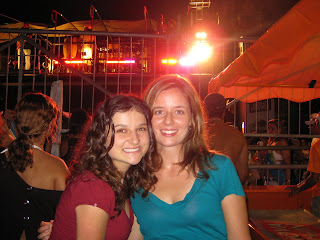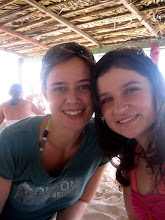It’s a good thing we love buses because Salvador was a whooping 22-hour (one way) bus ride away. We spent 4 days and 3 nights in Salvador, Brazil’s culture capital, famous for its Afro-Brazilan culture, powerful rhythms of the drum corps, mystical Candomblé, capoeira circles, and food with a heavy West-African influence.

Our super comfy back seats, strategically located next to the fridge with cold water
The highlights included…
… the historic city tour. Our guide, Josué, was hilarious! Not only did he take us to all the “traditional” tour places but also the tunnels that connect the churches in Pelourinho (some think they were used for smuggling, secret romantic encounters, and/or illegal slave trade but no one knows for sure). Our guide even had Joana stick her hand down a 300-year-old church toilet to take a picture of what was beneath it (surprise, it was trash).

Us in the heart of Pelourinho
…the Candomblé ceremony. Candomblé is a little-understood religion, rooted in Bahian culture, that was brought over by West African slaves. The candomblistas worship
orixás, or powerful spirits, and if a person has the gift, he or she can become a medium for the spirit. Interestingly, there are female, male and bi-sexual
orixás. The ceremonies can last for hours. First, the performers, all dressed in white, go around in a circle in a dance meant to invite the spirits. Afterwards, the dance becomes more heated and the bell is added to the three drums to conjure the spirits. Then one or a few of the candomblistas become “possessed” by the spirits, which manifests as shaking, writhing and shrieking. Many of the
orixás became syncretized with catholic saints over time and as a result candomblistas often go to both a Catholic church and a Candomblé house (our Candomblé house actually had a Catholic altar above the
orixá drawings).

Joana in the women's section, drawing of
orixás and a catholic altar in the background
… island hopping in Baía de Todos os Santos (Bay of All Saints). The morning was not promising with intermittent torrential downpours, however the boat had a band and a bar, both guaranteed to brighten any day. When we got to the first island, Ilha dos Frades, it was still raining, so everyone decided to make the best of it and just load up on chope beer. With enough beer in them, some people (Galina included) actually went swimming and afterwards showered right on the beach (the shower was conveniently available right in the middle of the
barraca). We also ended up buying matching bracelets from a vendor named Julio Cesar (because he was born on Bahia’s Independence Day – see the connection? We don’t either.) Galina got a bracelet for love and Joana’s was for happiness. By the time we left the first island, the weather was beautiful! The second island, Ilha de Itaparica, was much larger. On our island tour, we stopped by Fonte da Bica (fountain of youth), mineral water fountain from 1842, which had 3 faucets: love, health and money. Naturally, we drank from all 3. Just to annoy Joana, the guide told the story of a Portuguese man who visited the island and went to the fountain every day to pour the water down his pants, until someone (the guide claimed to have been himself) told him that although the fountains rejuvenates, it does not resuscitate. On the way back, the band played popular Brazilian tunes and the passengers, warmed by beer (and
caipirinhas!), sang along. One of the band members ended up getting Galina to get up and dance with them, which proved to be a feat of balance, since the boat was rocking quite a bit. Thank you, vestibular system, for not failing Galina at the time of need (yes, we are in med school).

island #1, which only had 70 residents

on island #2, out local guide was really excited that Joana was Portuguese

At an old Dutch (or Portuguese) fort in Itaparica

The Fountain of Youth - Galina drinking from the "love" faucet, Joana from the "money", "health" is in the middle

Dancing/balancing on the boat, one of the band members looked a lot like Jamie Foxx
… samba dancing. Friday night, we went to one of many outdoor bars for some chope and live music. Later on, the street turned into a dance floor. After a few dances, we got invited to another venue for some samba dancing. We ended up being the only non-Brazilians there (finally, a non-touristy place) and had a blast learning to samba from Bahia’s best. Galina even got to dance with a dance teacher (or so he claimed) who actually turned out to be a wonderful instructor, said she was doing pretty good (for a white girl?) and gave her a necklace as a
presente. Overall, it was a productive night – we greatly improved our samba and made some friends who walked us back to our hotel safely.

Samba starts on the streets of Pelourinho, then moves into the clubs
…the ribbons. Everywhere you go in Salvador, people will offer you different colored ribbons from Lembrança do Senhor do Bonfim da Bahia. You are supposed to tie the ribbon around your wrist in 3 knots, making a wish for every knot. Taking the ribbon off invites doom, so you just have to wait for it to fall off on its own. Joana cleverly picked a pink ribbon, which may not match any of her clothes but would certainly match a sunburn (thanks, equator!).

Pink is for love, purple is for health
… sad stuff. Salvador has many street dogs (Praça da Sé) and cats (everywhere else) that have to beg for food from tourists and go dumpster diving. Sadder still, is that walking back from samba at 3 AM, you can see little kids dumpster diving along with the homeless animals. The financial chasm between the tourists that seem to flood Pelourinho during the day and the kids who scavenge for their leftovers at night is truly staggering.
… the food. Bahian food is heavily influenced by its African origins and often cooked with dendê oil from West African palm. One of our favorites was the traditional
moqueca – a delicious stew made with coconut milk,
dendê oil, seafood and laced with
malagueta pepper. Naturally, everything is served/cooked with
farofa (manioc flour), which turns food yellow. In fact, yellow is now our favorite flavor.
Acarajé, bean and shrimp fritters, were ubiquitous, huge, and incredibly filling.

The deliciousness that is fish
moqueca (its yellow, of course)
… the music. The city is pulsating with rhythms of samba, reggae and just about any other type of music. Almost every bar and restaurant has live music by local performers, all of whom seem incredibly talented. How is it that a city like Salvador is overflowing with truly talented and original performers and then someone like Britney Spears makes it?
… Olodum. Olodum is the more famous of Salvador’s drum corps, they even did a video with Michael Jackson, which everyone in Pelourinho will happily remind you and even show you the exact streets and buildings where the taping took place (by the way did you hear he died?). We saw some of Olodum’s apprentices (some as young as 5) form a procession down the streets of Pelourinho. They were really good.

One of the drummers - they occasionally pick up the drums and throw them in the air (heavy metal drums, that is)
… capoeira. Capoeira, which was developed by the slaves as a means of self-defense against their masters, is said to have originated from a ritualistic Angolan dance. Capoeira was prohibited by slave owners and thus developed into a disguise of acrobatic dance. Now, capoeira circles are seen all over. The main instrument that accompanies the dance is the one-stringed
berimbau, which Galina acquired for $5 at one of the music stores, along with a stick and a rock needed to play it. God help her neighbors.

Capoeira circle on the street
… last, but definitely not least, shopping! The art in Salvador is everywhere! Many artists just set up shop on the streets of Pelourinho, while others occupy little stores and galleries. We went to several venues and galleries before settling on a few amazing pieces.

The art is everywhere!!!
P.S. Every 3-4 hours, the bus would stop at rest stations, which had little stores and food vendors. At one of the stores, we encountered Marx’s
Communist Manifesto, on no other than a love advice literature shelf, right behind
Sex Without Doubts. For some people, its photo-shopped images of supermodels, for others it’s the picture of proletariat as “grave-diggers” of the bourgeoisie. Go figure.
 Communist Manifesto
Communist Manifesto - always a good read (right after
Sex Without Doubts)
The bus also entertained us with some videos from the 80s, including classics like “Total Eclipse of the Heart” and “Love hurts.” Along with the oldies, they threw in an occasional Britney and Backstreet Boys – are they considered oldies now, too? Are we that old?
As always, additional pics are here: http://picasaweb.google.com/jperd114
 Evidently, pre-gaming is a universal concept. No alcohol is sold in the stadium, so everyone drinks before the game outside, on the sidewalks.
Evidently, pre-gaming is a universal concept. No alcohol is sold in the stadium, so everyone drinks before the game outside, on the sidewalks. The stadium. In the background, the banner on the side of the stadium states "Ceara Sporting Club - My reason for living."
The stadium. In the background, the banner on the side of the stadium states "Ceara Sporting Club - My reason for living." Ceara’s mascot is vovo (grandfather). UVa’s cavalier could stab his opponents with a saber; Ceara’s vovo could…bore them to death with his stories? But seriously, he is a very endearing mascot, who cheered his team to a 2:0 victory.
Ceara’s mascot is vovo (grandfather). UVa’s cavalier could stab his opponents with a saber; Ceara’s vovo could…bore them to death with his stories? But seriously, he is a very endearing mascot, who cheered his team to a 2:0 victory. Joke FAIL.
Joke FAIL.
 The dunes have a labyrinth where you can look at the sources of the colored sand. Our little sister was freaking out about the labyrinth, even though it only had 1 walkable path.
The dunes have a labyrinth where you can look at the sources of the colored sand. Our little sister was freaking out about the labyrinth, even though it only had 1 walkable path.
 There is also a mineral water fountain, naturally called the “fountain of youth,” which comes out of a small hole in the dunes.
There is also a mineral water fountain, naturally called the “fountain of youth,” which comes out of a small hole in the dunes. The "artistic" picture
The "artistic" picture  Morro Branco is just beautiful!
Morro Branco is just beautiful! Lying in very warm puddles created by the waves on the beach promotes tanning
Lying in very warm puddles created by the waves on the beach promotes tanning We also went swimming at night, it was fun, albeit cold
We also went swimming at night, it was fun, albeit cold We love our grandma!!!
We love our grandma!!!

 Proudly representing the red, way-too-white-for-Brazil and blue
Proudly representing the red, way-too-white-for-Brazil and blue One of the Floats and its fans
One of the Floats and its fans


 Joana and Manuela are clearly serious about their work
Joana and Manuela are clearly serious about their work Obviously, Galina and Robson also take the project seriously
Obviously, Galina and Robson also take the project seriously medicinal garden at a university satellite location
medicinal garden at a university satellite location



























